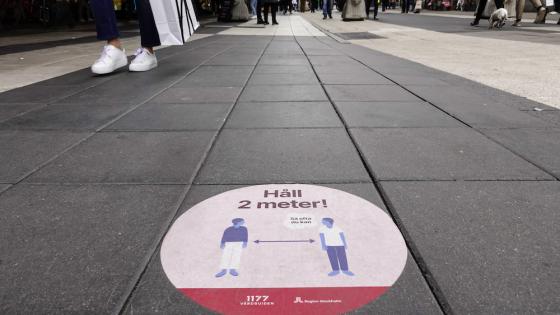Most countries around the world have implemented strong non-pharmaceutical interventions (NPIs) to slow the spread of COVID-19. While the effectiveness of these policies in terms of health outcomes has been shown in several studies (e.g. Born et al. 2020, Conyon et al. 2020, Juranek and Zoutman 2020), there are important concerns about the potential damage NPIs cause to the economy and labour markets (Andersen et al. 2020, Kong and Prinz 2020). Specifically, the severe restrictions and social distancing measures many countries have enforced (i.e. ‘lockdowns’) are assumed to inflict stark economic pain (Baldwin and Weder di Mauro 2020). Thus, the decision problem governments are facing is often seen as a trade-off between public health and the health of the economy.
In a new study, we use novel high-frequency (weekly) regional unemployment and furlough spells from all four Nordic countries (Norway, Sweden, Denmark, and Finland) to evaluate the economic effects of NPIs (Juranek et al. 2020). We employ these data to study the differential labour market effects of one of the most prominent policy variations observed during the COVID-19 pandemic. Sweden departed substantially from its neighbours in the response to the spread of the disease, refraining from closing schools, shutting down businesses or shops. Our estimation strategy draws on this natural experiment in the Nordics, comparing countries which were similarly exposed to the COVID-19 pandemic but responded to it in different ways.
The Nordic countries represent an ideal laboratory to study the differential impact of NPIs on labour market outcomes. First, the Nordic countries are similar with regard to the general economic environment (e.g. GDP per capita, trade openness), their labour markets, health care sectors, and the general institutional background. Second, due to geographical proximity and their economic interrelations these countries experienced similar trajectories of the COVID-19 pandemic: The 100th case of a confirmed infection occurred in Norway on 4 March, in Sweden on 6 March, in Denmark on 9 March, and in Finland on 12 March. The measures to slow the spread of COVID-19, however, differed substantially between the four countries. Starting in week 11 of 2020, Denmark, Norway, and Finland responded with strong NPIs to limit social interaction, while Sweden imposed much lighter restrictions.
The measures had direct implications for many types of economic activity: In Norway, Finland, and Denmark, the hospitality industry (such as bars, nightclubs, restaurants, and hotels) was largely shut down, personal services (e.g. hair dressers, masseurs, and dentists) were closed, shopping centres had to stop operating, and public transport was limited. In contrast, Sweden opted for much less strict measures, with restaurants and bars kept open (under certain proximity restrictions), and private businesses and shops being allowed to operate freely. In contrast to the very different NPIs imposed to curb the spread of COVID-19 between Sweden and its neighbours, all countries introduced similar government programs to soften the impact of the pandemic on the economy and labour markets (Alstadsæter et al. 2020, Bennedsen et al. 2020).
Since all Nordic countries were similarly exposed to the pandemic but only Sweden refrained from strict NPIs, a comparison of unemployment and furlough spells between Sweden and the other Nordic countries allows us to study the labour market effects of the restrictions. Therefore, we analyse weekly new unemployment and furlough spells from the Nordic countries at the regional level. A key strength of our study is that it not only covers the effect of the crisis on unemployment, but also on the number of people filing for one of the national furlough programs. We find that the number of furloughed workers during the pandemic is significantly larger than the number of workers that became unemployed. Therefore, including furloughed workers is of crucial importance when studying the labour market impact of the pandemic.
We compare labour market outcomes between Swedish regions and its Nordic neighbours in an event-study framework. Our comparison focuses on the regional number of new weekly unemployment and furlough spells between week 1 and week 21 of 2020 with the corresponding figures in 2019. Week 11 serves as the event date, when the lockdowns of Denmark, Finland, and Norway were implemented. To adjust for the general business cycle and seasonal effects we include a set of region-year and country-week fixed effects.
Our results are summarised in Figure 1.
Figure 1 Seasonally and regionally adjusted unemployment and furloughs per 100,000
Notes: The figure shows the event-study coefficients, including 95%-confidence intervals (standard errors clustered on the country-region level). The blue shaded vertical line indicates the week of the lockdowns in Denmark, Finland, and Norway (week 11). Panel A employs new weekly unemployment spells, panel B new weekly unemployment plus furlough spells, panel C cumulative unemployment spells, and panel D cumulative unemployment plus furlough spells as the respective outcome (all per 100,000 population).
Overall, the results suggest that the labour markets of all Nordic countries were hit hard by the pandemic, as well as by the subsequent NPIs. Starting in week 11 of 2020, we observe a sharp increase in newly unemployment and furlough spells especially for Norway and Denmark, but also for Finland. Sweden shows a similar but less pronounced peak in new unemployment and furlough spells, lagging behind the surge of its neighbours by around two to three weeks. When using the cumulative (total) number of new weekly unemployment and furlough spells, we again find the labour markets of Denmark and Norway to have suffered the most, followed by Finland and Sweden. Employing weekly regional stock data of furloughs (which is only available for Denmark and Sweden) shows a similar pattern. Specifically, we find a very large increase in Denmark exactly around the time of the lockdown in week 11, and for Sweden a similar but somewhat less strong increase around two to three weeks thereafter. In sum, the lockdowns of Norway and Denmark seem to have had the largest impact, followed by Finland and Sweden.
Our estimates on the labour market are in line, though somewhat higher, than Andersen et al. (2020). Using bank transaction data from Swedish and Danish bank clients, they find a 25% drop in spending for Sweden versus a 29% drop for Denmark. The difference of four percentage points amounts to a 14% larger drop for Denmark compared to Sweden. Qualitatively, our results are also in line with the recent IMF’s Country Focus (IMF 2020), showing that Sweden experienced a small increase in GDP for the first quarter of 2020, contrary to almost all other advanced economies. Finally, our results find similar, but larger negative effects of NPIs compared to the study of Kong and Prinz (2020), who analyse NPIs and unemployment insurance (UI) claims across US states. However, we believe the Nordic countries provide a setting of (i) more similar exposure (regarding time and space) to the spread of COVID-19, while at the same time having (ii) much more variation in NPI strictness than most US states.
Our study indicates that NPI strictness is not irrelevant in terms of labour market performance. However, we would like to emphasise that our analysis ends in week 21 of 2020. Thus, our results can only be informative about the short-term effects of lockdowns in the COVID-19 crisis. The coming weeks and months will tell us more about the medium-term to long-term effects of the Swedish strategy, and whether the country will weather the crisis economically different compared to its neighbours.
References
Alstadsæter, A, B Bratsberg, G Eielsen, W Kopczuk, S Markussen, O Raaum and K Røed (2020), “The first weeks of the coronavirus crisis: Who got hit, when and why? Evidence from Norway”, Covid Economics 15: 63–87.
Andersen, A, E Hansen, N Johannesen and A Sheridan (2020), “Consumer responses to the COVID-19 crisis: Evidence from bank account transaction data”, Covid Economics 7: 88–114.
Baldwin, R and B Weder di Mauro (2020), Mitigating the COVID Economic Crisis: Act Fast and Do Whatever It Takes, a VoxEU.org eBook, London: CEPR Press.
Bennedsen, M, B Larsen, I Schmutte and D Scur (2020), “Preserving job matches during the COVID-19 pandemic: Firm-level evidence on the role of government aid”, Covid Economics 27: 1–21.
Born, B, A Dietrich and G Mueller (2020), “Do lockdowns work? Acounterfactual for Sweden”, Covid Economics 16: 1-22.
Conyon, M J, L He and S Thomsen (2020), “Lockdowns and COVID-19 deaths in Scandinavia”, Covid Economics 26: 17–42.
IMF (2020), “Sweden: Will COVID-19 Economics be Different?”, IMF Country Focus, 4 June.
Juranek, S, J Paetzold, H Winner and F Zoutman (2020), “Labor market effects of COVID-19 in Sweden and its neighbors: Evidence from novel administrative data”, Covid Economics 42: 143–163.
Juranek, S and F Zoutman (2020), “The effect of social distancing measures on intensive care occupancy: Evidence on COVID-19 in Scandinavia”, CESifo Working Paper No. 8262.
Kong, E and D Prinz (2020), “The impact of shutdown policies on unemployment during a pandemic”, Covid Economics 17: 24–46.









